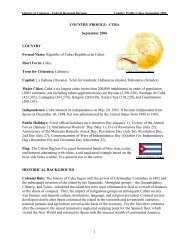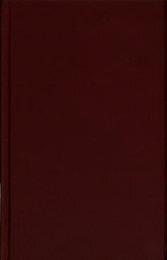Anton Webern's Six Pieces for Ocrhestra, op. 6, Arrangement for ...
Anton Webern's Six Pieces for Ocrhestra, op. 6, Arrangement for ...
Anton Webern's Six Pieces for Ocrhestra, op. 6, Arrangement for ...
Create successful ePaper yourself
Turn your PDF publications into a flip-book with our unique Google optimized e-Paper software.
First, Webern attempted to replace the solo instruments that were no longer<br />
available (mostly wind instruments) with the most suitable substitutes, i.e., with<br />
instruments of similar sonority; this meant, on the one hand, wind and stringed<br />
instruments of like register, and, on the other, either harmonium (<strong>for</strong> wind<br />
instruments), or piano (<strong>for</strong> celesta, harp or percussion). A particularly striking<br />
example of this kind of reinstrumentation is the beginning of the first piece, whose<br />
<strong>op</strong>ening phrase (consisting of a rising or descending line in sixteenth notes,<br />
followed by a high or low pedal tone, together with "punctuating" four-part chords)<br />
was changed as follows:<br />
1909: Fl. - Trp. - Cel. / Fl. - Hrn. - Stgs.<br />
1920: Fl. - Harm. - Piano / Fl. - Harm. - Stgs.<br />
The result is a timbral reduction: whereas there is a succession of five distinct tone<br />
colors in the original version, there are only three different sonorities in the chamber<br />
version.<br />
Second, Webern tried to preserve the many "homogeneous" chords of the full<br />
orchestra version (4 trumpets, 6 trombones, etc.) by assigning them either to the<br />
"multivoiced" instruments, i.e., harmonium or piano, or to the strings. While the<br />
sonorous integrity of the individual chords is thus retained, the timbral variety is<br />
limited to three types of sonority. In addition, the few heterogeneous sonorities of<br />
the original version were unified. This can be seen, <strong>for</strong> example, in the originally<br />
"blended" chord in measure 17 of the fifth piece (clarinet, contrabassoon, 4 horns,<br />
and strings) which, in the chamber version, is reduced to pure string sound enriched<br />
by a single tone of the harmonium.<br />
Third, Webern often removed the doublings characteristic of the version <strong>for</strong> full<br />
orchestra. Thus, in the chord just mentioned, the original version doubles five of the<br />
seven tones heard (c in double bass and contrabassoon, f in viola II and horn IV, d<br />
in violin I and horn II, a in violin II [b] and horn I, e-flat in violin II [a] and<br />
clarinet), whereas in the chamber version--as far as can be seen in the parts--no<br />
doubling occurs. 17



![Albert Einstein Papers [finding aid]. Library of Congress. [PDF ...](https://img.yumpu.com/21604228/1/190x245/albert-einstein-papers-finding-aid-library-of-congress-pdf-.jpg?quality=85)





![American Colony in Jerusalem Collection [finding aid]. Library of ...](https://img.yumpu.com/17941275/1/190x245/american-colony-in-jerusalem-collection-finding-aid-library-of-.jpg?quality=85)



![Piccard Family Papers [finding aid]. - American Memory - Library of ...](https://img.yumpu.com/17941234/1/190x245/piccard-family-papers-finding-aid-american-memory-library-of-.jpg?quality=85)


